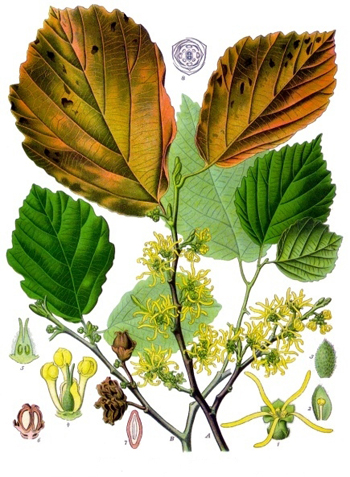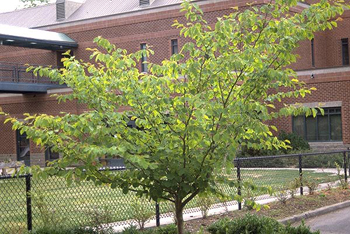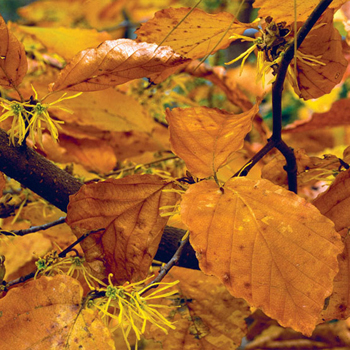Contents:
Common Names | Parts Usually Used | Plant(s) & Culture | Where Found | Medicinal Properties | Biochemical Information
Legends, Myths and Stories | Uses | Formulas or Dosages | How Sold | Bibliography
Scientific Names

- Hamamelis virginiana L.
- Hamamelidaceae
- Witch-hazel family
Common Names
- Hazel nut (not the American hazelnut (Corylus americana L.)
- Pistachio
- Snapping hazel
- Spotted alder
- Striped alder
- Tobacco wood
- Winterbloom
Parts Usually Used
Bark and leaves
Back to Top

Description of Plant(s) and Culture
Witch hazel is a tall, deciduous shrub or small tree; growing to a height of up to 15 feet, the stems and branches are covered with scaly gray to light, brown bark. The alternate, elliptic to obovate leaves are coarsely toothed and often are finely hairy on the veins underneath. The fragrant, light yellow flowers have 4 strap-shaped petals and grow in nodding, axillary clusters, blooming in autumn when the leaves are falling. The fruit is a woody capsule which ejects two shining black seeds when they ripen during the summer or autumn following the flowers.
Another variety: The Chinese witch hazel (H. japonica), Chinese name Chiu-lu-mei, does not seem to have been used medicinally in China.
Back to Top

Where Found
Grows in damp woods from Nova Scotia to Georgia and Nebraska, Minnesota south to Florida and Texas; it is also cultivated elsewhere for its autumn-blooming flowers.
Back to Top
Medicinal Properties
Astringent, hemostatic, sedative, styptic, tonic
Back to Top
Biochemical Information
Tannin, traces of essential oil, flavonoids, choline and a saponin. The bark contains less tannin.
Back to Top
Legends, Myths and Stories
Witch hazel was first used, as far as we know, by the Native Americans.
The Native Americans watched for this plant to be in bloom; they took it as an indication that the frost was entirely gone and they might sow their corn. Also, it was a good spring herald for a good horse race.
Many wells have been dug in this land where the witch hazel has indicated. At one time, one would hear occasionally, of people making a business of “water witching.” Despite the unscientific concept, some folks still swear by its many successes.
Witch hazel’s name is thought to be derived from early American settlers who used this plant’s forked branches as a divining rod in their searches for water or gold, just as the hazel’s branches were used in England. It is also possible that the name was transferred from the English wych-hazel, or wych-elm, with its ultimate origin in the Old English word wican, meaning “to yield”. The reference, of course, would be the springiness of the wood.
Back to Top
Uses
Leaves and bark have served mostly to make astringent preparations, which have been taken internally for diarrhea and used externally as a rinse or gargle for mouth and throat irritations, colds, and as a vaginal douche for vaginitis. For skin irritations, bruises, varicose veins, tonic after abortions, insect bites and stings, minor burns, and poison ivy, an ointment made from the fluid extract or a poultice can be applied. Local application for gonorrhea and leukorrhea. A poultice made from the inner bark is said to be effective for hemorrhoids and for eye inflammation. The inner bark also has sedative and hemostatic properties.
Twig tea was rubbed on athletes’ legs to keep muscles limber, relieve lameness, wounds, and swellings; tea for bloody dysentery, cholera, cough, and asthma. Used externally for bruises and sore muscles, minor pains, itching. Diluted with water or mixed with honey, the powder may be topically applied as a dressing for burns, scalds, scrapes, bruises, abrasions, and crushed toes and fingers. An effective wash for sunburn, inflamed breasts, and for various rashes. It is often used as an after-shave lotion.
Back to Top
Formulas or Dosages
Decoction: boil 1 tsp. bark or leaves in 1 cup water 15-20 minutes. Take 1 cup a day, a mouthful at a time.
Tincture: a dose is from 5-20 drops.
Ointment: mix 1 part fluid extract with 9 parts lard or vaseline.
Witch hazel “extract”, used externally as a skin toner, is a common item in American medicine cabinets.
Back to Top
How Sold
Over-the-counter products are available in every pharmacy. Bottled witch-hazel water, widely available, is a steam distillate that does not contain the astringent tannins of the shrub. Apply to irritated areas several times a day.
Do not take internally witch hazel purchased at the drug store. It contains an alcohol that is not intended for internal use.
Back to Top
Bibliography
![]() The Herb Book
The Herb Book, by John Lust, Bantam Books, 666 Fifth Avenue, New York, NY. copyright 1974.
![]() The Herbalist Almanac
The Herbalist Almanac, by Clarence Meyer, Meyerbooks, publisher, PO Box 427, Glenwood, Illinois 60425, copyright 1988, fifth printing, 1994
![]() Back to Eden
Back to Eden, by Jethro Kloss; Back to Eden Publishing Co., Loma Linda, CA 92354, Original copyright 1939, revised edition 1994
![]() Chinese Medicinal Herbs
Chinese Medicinal Herbs, compiled by Shih-Chen Li, Georgetown Press, San Francisco, California, 1973.
![]() Eastern/Central Medicinal Plants
Eastern/Central Medicinal Plants, by Steven Foster and James A. Duke., Houghton Mifflin Company, 215 Park Avenue South, New York, NY 10000
![]() The Nature Doctor: A Manual of Traditional and Complementary Medicine
The Nature Doctor: A Manual of Traditional and Complementary Medicine, by Dr. H.C.A. Vogel; Keats Publishing, Inc., 27 Pine Street (Box 876) New Canaan, CT. 06840-0876. Copyright Verlag A. Vogel, Teufen (AR) Switzerland 1952, 1991
Herbal Gardening, compiled by The Robison York State Herb Garden, Cornell Plantations, Matthaei Botanical Gardens of the University of Michigan, University of California Botanical Garden, Berkeley., Pantheon Books, Knopf Publishing Group, New York, 1994, first edition
 Old Ways Rediscovered
Old Ways Rediscovered, by Clarence Meyer, Meyerbooks, publisher, PO Box 427, Glenwood, Illinois 60425, published from 1954, print 1988
 Earl Mindell’s Herb Bible
Earl Mindell’s Herb Bible, by Earl Mindell, R.Ph., Ph.D., Simon & Schuster/Fireside, Rockefeller Center 1230 Avenue of the Americas, New York, New York 10020
![]() Planetary Herbology
Planetary Herbology, by Michael Tierra, C.A., N.D., O.M.D., Lotus Press, PO Box 325, Twin Lakes. WI 53181., Copyright 1988, published 1992
![]() The Complete Medicinal Herbal
The Complete Medicinal Herbal, by Penelope Ody, Dorling Kindersley, Inc, 232 Madison Avenue, New York, NY 10016, First American Edition, copyright 1993
![]() Indian Herbalogy of North America
Indian Herbalogy of North America, by Alma R. Hutchens, Shambala Publications, Inc., Horticultural Hall, 300 Massachusetts Avenue, Boston, Massachusetts 02115, 1973
![]() American Folk Medicine
American Folk Medicine, by Clarence Meyer, Meyerbooks, publisher, PO Box 427, Glenwood, Illinois 60425, 1973
![]() Webster’s New World Dictionary
Webster’s New World Dictionary, Third College Edition, Victoria Neufeldt, Editor in Chief, New World Dictionaries: A Division of Simon & Schuster, Inc., 15 Columbus Circle, New York, NY 10023
 An Instant Guide to Medicinal Plants
An Instant Guide to Medicinal Plants, by Pamela Forey and Ruth Lindsay, Crescent Books (January 27, 1992).
![]() The Yoga of Herbs: An Ayurvedic Guide to Herbal Medicine
The Yoga of Herbs: An Ayurvedic Guide to Herbal Medicine, by Dr. David Frawley & Dr. Vasant Lad, Lotus Press, Twin Lakes, Wisconsin, Second edition, 1988.
 The Rodale Herb Book: How to Use, Grow, and Buy Nature’s Miracle Plants (An Organic gardening and farming book)
The Rodale Herb Book: How to Use, Grow, and Buy Nature’s Miracle Plants (An Organic gardening and farming book), edited by William H. Hylton, Rodale Press, Inc. Emmaus, PA, 18049., 1974
